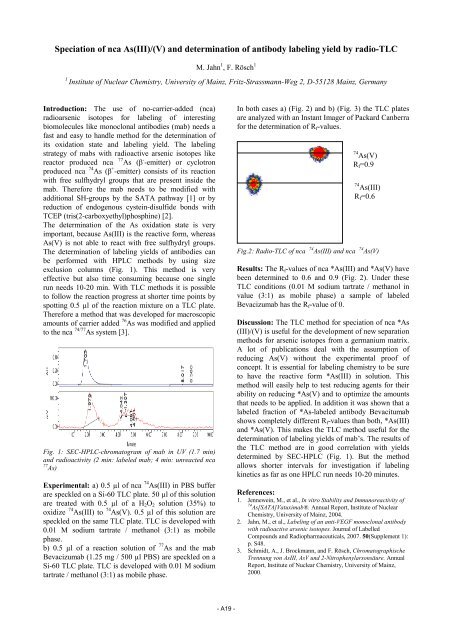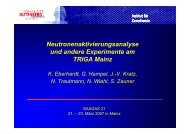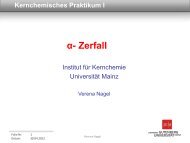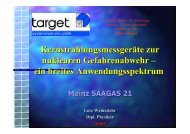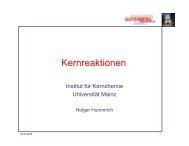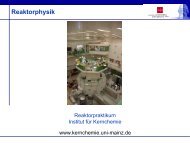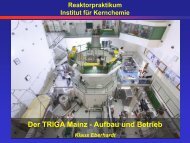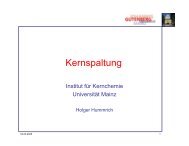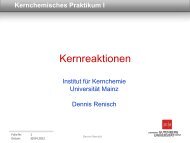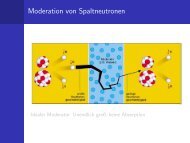jahresbericht 2007 - Institut für Kernchemie - Johannes Gutenberg ...
jahresbericht 2007 - Institut für Kernchemie - Johannes Gutenberg ...
jahresbericht 2007 - Institut für Kernchemie - Johannes Gutenberg ...
Create successful ePaper yourself
Turn your PDF publications into a flip-book with our unique Google optimized e-Paper software.
Speciation of nca As(III)/(V) and determination of antibody labeling yield by radio-TLC<br />
M. Jahn 1 , F. Rösch 1<br />
1 <strong>Institut</strong>e of Nuclear Chemistry, University of Mainz, Fritz-Strassmann-Weg 2, D-55128 Mainz, Germany<br />
Introduction: The use of no-carrier-added (nca)<br />
radioarsenic isotopes for labeling of interesting<br />
biomolecules like monoclonal antibodies (mab) needs a<br />
fast and easy to handle method for the determination of<br />
its oxidation state and labeling yield. The labeling<br />
strategy of mabs with radioactive arsenic isotopes like<br />
reactor produced nca 77 As (β - -emitter) or cyclotron<br />
produced nca 74 As (β + -emitter) consists of its reaction<br />
with free sulfhydryl groups that are present inside the<br />
mab. Therefore the mab needs to be modified with<br />
additional SH-groups by the SATA pathway [1] or by<br />
reduction of endogenous cystein-disulfide bonds with<br />
TCEP (tris(2-carboxyethyl)phosphine) [2].<br />
The determination of the As oxidation state is very<br />
important, because As(III) is the reactive form, whereas<br />
As(V) is not able to react with free sulfhydryl groups.<br />
The determination of labeling yields of antibodies can<br />
be performed with HPLC methods by using size<br />
exclusion columns (Fig. 1). This method is very<br />
effective but also time consuming because one single<br />
run needs 10-20 min. With TLC methods it is possible<br />
to follow the reaction progress at shorter time points by<br />
spotting 0.5 µl of the reaction mixture on a TLC plate.<br />
Therefore a method that was developed for macroscopic<br />
amounts of carrier added 76 As was modified and applied<br />
to the nca 74/77 As system [3].<br />
Fig. 1: SEC-HPLC-chromatogram of mab in UV (1.7 min)<br />
and radioactivity (2 min: labeled mab; 4 min: unreacted nca<br />
77 As)<br />
Experimental: a) 0.5 µl of nca 74 As(III) in PBS buffer<br />
are speckled on a Si-60 TLC plate. 50 µl of this solution<br />
are treated with 0.5 µl of a H 2 O 2 solution (35%) to<br />
oxidize 74 As(III) to 74 As(V). 0.5 µl of this solution are<br />
speckled on the same TLC plate. TLC is developed with<br />
0.01 M sodium tartrate / methanol (3:1) as mobile<br />
phase.<br />
b) 0.5 µl of a reaction solution of 77 As and the mab<br />
Bevacizumab (1.25 mg / 500 µl PBS) are speckled on a<br />
Si-60 TLC plate. TLC is developed with 0.01 M sodium<br />
tartrate / methanol (3:1) as mobile phase.<br />
In both cases a) (Fig. 2) and b) (Fig. 3) the TLC plates<br />
are analyzed with an Instant Imager of Packard Canberra<br />
for the determination of R f -values.<br />
74 As(V)<br />
R f =0.9<br />
74 As(III)<br />
R f =0.6<br />
Fig.2: Radio-TLC of nca 74 As(III) and nca 74 As(V)<br />
Results: The R f -values of nca *As(III) and *As(V) have<br />
been determined to 0.6 and 0.9 (Fig. 2). Under these<br />
TLC conditions (0.01 M sodium tartrate / methanol in<br />
value (3:1) as mobile phase) a sample of labeled<br />
Bevacizumab has the R f -value of 0.<br />
Discussion: The TLC method for speciation of nca *As<br />
(III)/(V) is useful for the development of new separation<br />
methods for arsenic isotopes from a germanium matrix.<br />
A lot of publications deal with the assumption of<br />
reducing As(V) without the experimental proof of<br />
concept. It is essential for labeling chemistry to be sure<br />
to have the reactive form *As(III) in solution. This<br />
method will easily help to test reducing agents for their<br />
ability on reducing *As(V) and to optimize the amounts<br />
that needs to be applied. In addition it was shown that a<br />
labeled fraction of *As-labeled antibody Bevacitumab<br />
shows completely different R f -values than both, *As(III)<br />
and *As(V). This makes the TLC method useful for the<br />
determination of labeling yields of mab’s. The results of<br />
the TLC method are in good correlation with yields<br />
determined by SEC-HPLC (Fig. 1). But the method<br />
allows shorter intervals for investigation if labeling<br />
kinetics as far as one HPLC run needs 10-20 minutes.<br />
References:<br />
1. Jennewein, M., et al., In vitro Stability and Immunoreactivity of<br />
74 As[SATA]Vatuximab®. Annual Report, <strong>Institut</strong>e of Nuclear<br />
Chemistry, University of Mainz, 2004.<br />
2. Jahn, M., et al., Labeling of an anti-VEGF monoclonal antibody<br />
with radioactive arsenic isotopes. Journal of Labelled<br />
Compounds and Radiopharmaceuticals, <strong>2007</strong>. 50(Supplement 1):<br />
p. S48.<br />
3. Schmidt, A., J. Brockmann, and F. Rösch, Chromatographische<br />
Trennung von AsIII, AsV und 2-Nitrophenylarsonsäure. Annual<br />
Report, <strong>Institut</strong>e of Nuclear Chemistry, University of Mainz,<br />
2000.<br />
- A19 -


